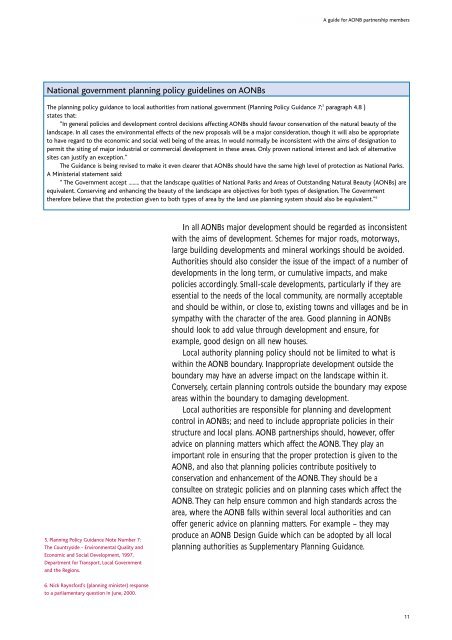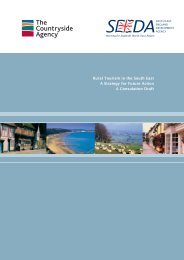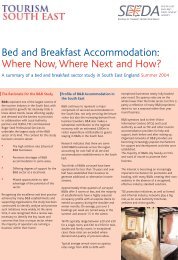Areas of Outstanding Natural Beauty - Publications and products
Areas of Outstanding Natural Beauty - Publications and products
Areas of Outstanding Natural Beauty - Publications and products
Create successful ePaper yourself
Turn your PDF publications into a flip-book with our unique Google optimized e-Paper software.
A guide for AONB partnership members<br />
National government planning policy guidelines on AONBs<br />
The planning policy guidance to local authorities from national government (Planning Policy Guidance 7; 5 paragraph 4.8 )<br />
states that:<br />
“In general policies <strong>and</strong> development control decisions affecting AONBs should favour conservation <strong>of</strong> the natural beauty <strong>of</strong> the<br />
l<strong>and</strong>scape. In all cases the environmental effects <strong>of</strong> the new proposals will be a major consideration, though it will also be appropriate<br />
to have regard to the economic <strong>and</strong> social well being <strong>of</strong> the areas. In would normally be inconsistent with the aims <strong>of</strong> designation to<br />
permit the siting <strong>of</strong> major industrial or commercial development in these areas. Only proven national interest <strong>and</strong> lack <strong>of</strong> alternative<br />
sites can justify an exception.”<br />
The Guidance is being revised to make it even clearer that AONBs should have the same high level <strong>of</strong> protection as National Parks.<br />
A Ministerial statement said:<br />
“ The Government accept ........ that the l<strong>and</strong>scape qualities <strong>of</strong> National Parks <strong>and</strong> <strong>Areas</strong> <strong>of</strong> <strong>Outst<strong>and</strong>ing</strong> <strong>Natural</strong> <strong>Beauty</strong> (AONBs) are<br />
equivalent. Conserving <strong>and</strong> enhancing the beauty <strong>of</strong> the l<strong>and</strong>scape are objectives for both types <strong>of</strong> designation. The Government<br />
therefore believe that the protection given to both types <strong>of</strong> area by the l<strong>and</strong> use planning system should also be equivalent.” 6<br />
5. Planning Policy Guidance Note Number 7:<br />
The Countryside - Environmental Quality <strong>and</strong><br />
Economic <strong>and</strong> Social Development, 1997,<br />
Department for Transport, Local Government<br />
<strong>and</strong> the Regions.<br />
In all AONBs major development should be regarded as inconsistent<br />
with the aims <strong>of</strong> development. Schemes for major roads, motorways,<br />
large building developments <strong>and</strong> mineral workings should be avoided.<br />
Authorities should also consider the issue <strong>of</strong> the impact <strong>of</strong> a number <strong>of</strong><br />
developments in the long term, or cumulative impacts, <strong>and</strong> make<br />
policies accordingly. Small-scale developments, particularly if they are<br />
essential to the needs <strong>of</strong> the local community, are normally acceptable<br />
<strong>and</strong> should be within, or close to, existing towns <strong>and</strong> villages <strong>and</strong> be in<br />
sympathy with the character <strong>of</strong> the area. Good planning in AONBs<br />
should look to add value through development <strong>and</strong> ensure, for<br />
example, good design on all new houses.<br />
Local authority planning policy should not be limited to what is<br />
within the AONB boundary. Inappropriate development outside the<br />
boundary may have an adverse impact on the l<strong>and</strong>scape within it.<br />
Conversely, certain planning controls outside the boundary may expose<br />
areas within the boundary to damaging development.<br />
Local authorities are responsible for planning <strong>and</strong> development<br />
control in AONBs; <strong>and</strong> need to include appropriate policies in their<br />
structure <strong>and</strong> local plans. AONB partnerships should, however, <strong>of</strong>fer<br />
advice on planning matters which affect the AONB. They play an<br />
important role in ensuring that the proper protection is given to the<br />
AONB, <strong>and</strong> also that planning policies contribute positively to<br />
conservation <strong>and</strong> enhancement <strong>of</strong> the AONB. They should be a<br />
consultee on strategic policies <strong>and</strong> on planning cases which affect the<br />
AONB. They can help ensure common <strong>and</strong> high st<strong>and</strong>ards across the<br />
area, where the AONB falls within several local authorities <strong>and</strong> can<br />
<strong>of</strong>fer generic advice on planning matters. For example – they may<br />
produce an AONB Design Guide which can be adopted by all local<br />
planning authorities as Supplementary Planning Guidance.<br />
6. Nick Raynsford’s (planning minister) response<br />
to a parliamentary question in June, 2000.<br />
11
















